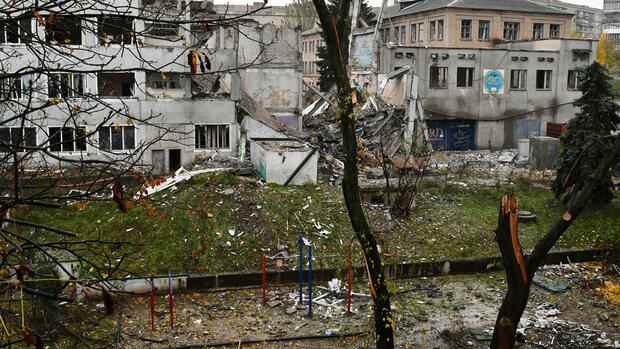Riga According to a team of economists, Ukraine’s reconstruction plan, presented by the government in Lugano in July, needs a number of improvements. This emerges from the results of a study by the Vienna Institute for International Economic Comparisons (WIIW) published on Wednesday.
The plan, which is designed for ten years and two phases, includes 850 concrete projects. The largest items in it are intended for the reconstruction and modernization of buildings and infrastructure, as well as for the repair of logistics and transport networks. The government needs money to implement it – about $750 billion, without military spending the total would still be $450 billion.
The Viennese economists set this number a little lower: “Assuming that the most intense phase of the war lasts until mid-2023, the study assumes that international donors will contribute somewhat less, namely around 410 billion US dollars, to reconstruction must,” the researchers explain.
“Still a huge sum”
“Of course, that’s still a huge sum,” said co-author Richard Grieveson, Associate Director of WIIW. “The EU, which has a strong self-interest in a democratic and prosperous Ukraine and has made the country a candidate for accession, will therefore have to massively increase its efforts in this area,” says the economist.
According to researchers, the Ukrainian government is overestimating post-war growth prospects.
(Photo: IVOR PRICKETT/The New York Times)
However, the goal of a fivefold increase in the country’s economic output to $500 billion by 2032 seems unrealistic. The experts came to this conclusion by comparing them with developments in other former war zones such as Bosnia and Croatia in the 1990s. Bosnia tripled its gross domestic product (GDP) between 1996 and 2005, and Croatia doubled it between 1994 and 2003.
In addition, the researchers criticize the distribution of funds across different sectors. This was “not well justified”. In particular, the classification of heavy industry and agricultural production as sectors with high added value is “doubtful”. According to the plan, these areas should have priority in the reconstruction and be funded with billions.
In addition, other items are underestimated, such as the financing needs for defense and security, which is estimated at 50 billion dollars by 2032. This amount seems “rather low” in view of the “intensity of the military struggle” and the “immense challenges in the transformation of the defense industry and the modernization of the Ukrainian armed forces,” the study says.
Just think of building transregional transport links or aligning reconstruction efforts with EU standards. Tetiana Bogdan, Growford Institute of Economics in Kyiv and visiting researcher at WIIW
Michael Landesmann, former scientific director of the WIIW and co-author of the study, complains: “From our point of view, this represents a backward-looking industrial policy that means preserving existing structures instead of forcing the necessary structural change towards a sustainable and green economy.” The Ukraine has great potential, especially in the IT sector or in environmental technologies.
>> Read here: The uncanny power in the background – How the Ukrainian secret service works
With a view to planned tax cuts, the authors even see a potential obstacle to the intended EU membership. In concrete terms, a ban on the reimbursement of VAT on raw material exports is planned, as well as state support for heavy industry. According to the study, these measures “clearly contradict EU law”.
In a situation in which “hundreds of billions of US dollars are needed for reconstruction” and “the national debt ratio is also to be reduced”, the plans to reduce the tax and contribution ratio to 30 percent of gross domestic product are “poorly thought out”. .
Implement planned measures
In order to put the planned measures into practice, the Ukrainian government’s plan envisages a decentralized approach. Development projects in different regions are to be led by different international partners. Great Britain would therefore be responsible for the region around Kyiv, Sweden for Odessa. The researchers are skeptical.
At the end of October, an international expert conference in Berlin discussed the matter. Politicians had repeatedly emphasized that the reconstruction should promote the modernization of the country.
(Photo: IMAGO/Christian Spicker)
Tetiana Bogdan, scientific director of the Growford Institute of Economics in Kyiv and visiting researcher at the WIIW, explains that in order to have a nationwide impact, the central reconstruction programs must be designed and managed at the state level. “Just think about building interregional transport links or aligning reconstruction efforts with EU standards,” says Bogdan.
However, the efforts to tackle institutional reforms, to curtail the power of the “so far omnipresent oligarchs” and “to bring Ukraine closer to EU standards” are positive.
>> Read here: Read all current developments on the Ukraine war in the Newsblog
In addition to Ukraine itself, the international community is also working intensively on the question of how reconstruction can succeed. For example, institutions such as the World Bank, the EU Commission or the think tank German Marshall Fund of the United States have published corresponding plans and calculations. However, these plans mostly focus on the planned support by the respective institution.
At the end of October, an international expert conference in Berlin discussed the matter. Politicians had repeatedly emphasized that the reconstruction should promote the modernization of the country.
More: Essay – That’s why the West is fooling itself with promises to rebuild Ukraine
